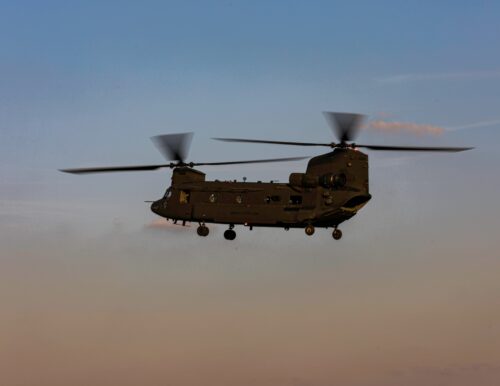Soldiers from the 101st Combat Aviation Brigade (CAB), 101st Airborne Division (Air Assault), have conducted a crucial operational assessment of the Boeing CH-47F Block II Chinook helicopter at Fort Campbell, Kentucky, according to a DVIDS article published on Mar. 20th.

Photo by Sgt. Matthew Wantroba
Throughout the preceding year, aircrew members from the 6th General Support Aviation Battalion (GSAB), 101st CAB, actively participated in flying the new CH-47F Block II Chinook. This assessment included Special User Evaluation (SUE) #1 in April 2024, which represented the initial Soldier-led evaluation of the Block II. The extensive feedback provided by the aircrews proved invaluable, leading to subsequent changes and SUE #2, which took place in November 2024 at Fort Campbell. Notably, the soldiers specifically requested and subsequently conducted training on new capabilities, including aerial gunnery from rear cabin windows, Fast Rope Insertion and Extraction System (FRIES) training, and additional sling load iterations, all aimed at gaining familiarity with the Block II’s enhanced lifting capacity.
Feedback from the 101st CAB soldiers has highlighted the advancements offered by the Block II Chinook. Chief Warrant Officer 2 Jordan Brooks, a maintenance test pilot with Golf Company, 6-101 GSAB, described the flying experience as similar to the currently fielded CH-47F but with noticeably more power available. A key improvement for Brooks was the significant increase in the Chinook’s weight-lifting capacity, stating that Block II Chinooks could transport more soldiers and equipment over greater distances compared to the Block I variant. As a maintenance test pilot, Brooks also appreciated the improvements made to the main rotor head, which promise to ease and expedite aircrew maintenance, potentially minimising aircraft downtime. Reflecting on the experience, Brooks felt it provided an ideal opportunity to offer genuine insights and influence the future development of the CH-47 for the Army.
Chief Warrant Officer 2 David Lantz, an instructor pilot in Bravo Company 6-101 GSAB, also had the opportunity to evaluate the Block II. He praised the upgraded software and displays in the cockpit, which facilitated easier access to crucial data for assessing the aircraft’s capabilities across various mission profiles. Lantz was particularly impressed by the inclusion of four gun mounts for gunnery, noting that this doubling of shooting capability would save time and fuel during training and enhance overall lethality. He further emphasised that the Block II’s enhancements in gross weight, endurance, and speed align perfectly with the 101st’s demanding requirements for large-scale, long-range air assault missions.
Boeing announced on Jul. 1, 2024, the delivery of the first CH-47F Block II Chinook aircraft to the U.S. Army. This marked the beginning of a program aimed at acquiring up to 465 Chinooks in the Block II configuration for the service. Boeing asserted that the Block II offers enhanced capability and survivability for global missions and positions the aircraft for sustained modernisation and support. The design also anticipates and accommodates future technology upgrades. Boeing also highlighted that the improved reliability of the new rotor system will minimise unscheduled maintenance, while the simplified fuel system will enhance sustainment efficiency, reducing both maintenance burden and cost.
Prior to the 101st CAB’s evaluations detailed in the DVIDS article, the Army conducted a user demonstration of the modernized CH-47F Block II during Operation Lethal Eagle, as reported on Jul. 1, 2024. This demonstration, hosted by the Cargo Helicopters Project Office, aimed to assess the CH-47F Block II in a realistic operational environment and gather data to inform future testing, evaluation, and development.
The feedback garnered from the 101st CAB’s assessments, combined with the data collected during the earlier user demonstration, will play a crucial role in shaping decisions regarding the future fielding of the modernized CH-47 to Army units. The anticipated implementation of the Block II Chinook holds the potential to significantly enhance the 101st Airborne Division’s (Air Assault) large-scale, long-range air assault capabilities, empowering commanders to move greater numbers of soldiers and equipment more rapidly and over longer distances. Maj Jake Bitonel, Assistant Program Manager CH-47F Modernization, affirmed that the CH-47 Block II offers combatant commanders a substantial increase in operational reliability and capability. The Cargo Helicopter Project Management Office anticipates its next major acquisition milestone for the CH-47F Block II in 2025, with the subsequent two years dedicated to completing all necessary requirements before the aircraft is fielded. Once operational, the Block II is projected to have a significant impact on the future of Army aviation, improving safety, speed, and lethality for ground forces.
For more information, hit the Source below
We need one CH-47 for the Udvar Hazy Museum.